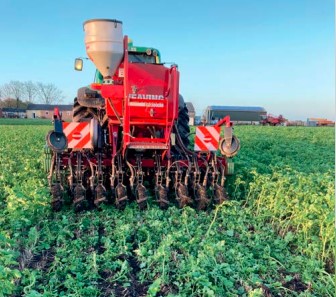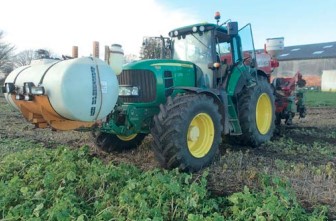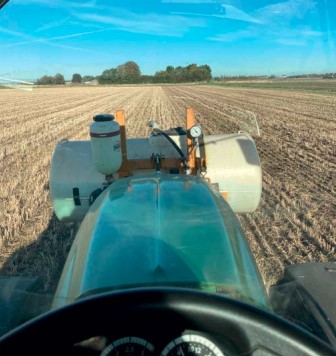
I farm in partnership with my wife Jayne, in the Cambridgeshire Fens near Peterborough. We started farming together in 1989 when I left the family farm having gained our first tenancy on an 33ha County Council Farm. It is staggering to think that we equipped the farm for less than £10000, including a 15-yearold combine for £1500, but with both of us also doing some off farm work we had a couple of happy years there. Over the years we have moved farm twice to gain larger tenancies, inherited my father’s share of the family farm, and bought a bit more land along the way. Our 2 sons have good careers outside of agriculture, but they will still occasionally roll their sleeves up and help at harvest. We now farm 220 ha of mainly skirt fen land in 3 blocks around Peterborough, 30% owned and 70% rented. Because of the distance between the blocks, the smaller two parcels to the north are ran with a collaborator/contractor doing much of the work, with some direct drilling, while our main farm at Whittlesey is worked by myself with a fleet of largely ‘classic’ machinery on a ‘Conservation Ag’ basis.
We share farmed extra land for a while, and grew potatoes and sugar beet for many years, but dropped potatoes around 10 years ago. At this point we largely stopped ploughing and started on a system of shallow tillage using a Vaderstad Carrier, with subsoiling as required. I didn’t realise at the time, but this was a good way of preparing our soils for the move to no tillage. The system worked well, and we managed to keep blackgrass at a modest level on most of the land, while also growing consistently good yields of cereals and sugar beet. We started investigating ‘Direct Drilling’ some years ago, visiting a few people already not tilling and we also tried a few drills. One of my collaborative colleagues bought a Weaving Big Disc drill, and from around 2014 we started establishing some crops with it, and our sugar beet and OSR using a Sly Strip Cat system.

Having gained confidence in the process, we decided to acquire our own no till drill, and considered the options of buying second hand or new. Unfortunately, with a modest acreage, and the shortage of second hand no till drills on the market it was a challenge to find such a machine. Happily, help was at hand, and we were fortunate to gain funding from the Fens LEADER group project which was part of the Rural Development Programme (RDPE). LEADER had various aims and objectives, including modernising and improving sustainability, and encouraging strategies to protect soils, and reduce Greenhouse gas (GHG) emissions. On this basis I decided to try an application for LEADER funding. The bureaucracy involved was daunting, but after a very comprehensive application procedure we were eventually awarded a grant of over £13500 which we used to acquire a new British built Weaving GD 3m disc coulter direct drill which arrived in July 2016.

I believe we were possibly the first LEADER funded drill in the country, and we had to sign up for some interesting projected outcomes including cost savings, fuel savings, reducing greenhouse gas (GHG) emissions and sharing knowledge. The new drill arrived just in time for our annual farm open day in 2016, and the 50 or so visiting farmers here primarily to look at KWS wheat varieties could also look at the shiny new drill and discuss our planned strategy. This started the ‘No-Till in the Fens’ project of knowledge transfer that was a condition of our grant.
I knew then that I would have liked two drills, one tine, and one disc, but could only afford one, and plumped for disc. I believe the GD was a good choice but regret not going for a larger trailed one. We bought a second-hand front tyre press to go on the front linkage to consolidate our sometimes fluffy lighter soils, and also counter the weight of the mounted drill. We had identified with our earlier no till experience, that the headlands and some sidelands of fields were slightly compacted due to turning of machinery, so we also bought a 40 year old Howard Paraplow for £600 to cheaply alleviate headland issues.

I set off drilling straight into stubbles, including fresh lifted beet land, and the GD was very impressive. We applied slug pellets with the drill after OSR and this proved to be very wise. We put some cover crops in and drilled straight into them in the spring. Harvest 2017 was nervously anticipated, with 95% of our crops direct drilled, but except for some heavy land beans, yields were right up with our 5-year average, with considerably reduced costs. Our small area of heavy land we realised needed easing gradually into the no till system… In autumn 2017 we had the dubious privilege of being selected for a post LEADER grant inspection by the RPA. This caused some fresh challenges; as part of the application claimed some positive outputs involving cost savings, fuel savings, reducing GHG emissions and sharing knowledge as mentioned earlier.
Analysis of accounts and other data allowed us to show we had surpassed the fuel and cost savings, and the success of our open days and other events had ticked the box for knowledge transfer, with 180 stakeholders engaged. The GHG emissions initially looked difficult, but the internet was my friend, and I found some conversion factors to show that the fuel saving alone also translated to a GHG saving that more than hit our target.
We have since gained the confidence to sell our plough and cultivation equipment, and pursue a strategy of no till establishment, with some occasional loosening of soil as deemed necessary. Interestingly, our yield maps showed that our paraplowed headlands now sometimes yielded slightly better than the field middles, which means we are not afraid of paraplowing a whole field should it be necessary, but we hope the need for this will diminish.

This system has worked well, with yields maintained, and over the years we started to learn more about a ‘Conservation Ag’ approach that went further than simply not tilling land. While we have found many sources of knowledge useful on our path, including this magazine, and the excellent organisation that is BASE, we have also been fortunate in gaining first-hand advice from other sources. Our agronomist Rob Wilkinson of Strutt and Parker, has been very supportive of the system, and also brought Ian Robertson of Sustainable Soil Management along to help refine our strategies on soil management, and the use of biologicals etc. We are also fortunate to have regular visits from Philip Wright of Wright Resolutions, partly as a consultant to advise, and partly to conduct some joint on-farm trials including tyre pressure trials, soil loosening and biological soil management effects.
We now have refined our system and work on a few agreed principles. We have added a second-hand 2013 Weaving Sabretine drill to our modest fleet, and I overhauled and upgraded it last year. We also have still the GD which is now in it’s 6th season and has recently had new closing wheels/tyres and some new bearings. Both drills and our 5 leg paraplow have liquid fertiliser/ amendment kits fitted using components sourced from SK Sprayers Ltd, and all are fed from a front tank that I made up using a second hand Knight front sprayer tank. An old, trailed press is used to consolidate paraplowed land, and a set of heavy rolls with hydraulic paddles are used post drilling if needed, and also as a ‘Straw Rake’ on occasion. We sell most of our straw, but use some of the proceeds to buy and establish multi species cover crops. I prefer to keep growing roots in the soil when possible, but we do rotationally return some straw as well. The recent wet years have caused some issues with compaction from the weight of rain, and washing down of fine soil particles, so we actually paraplowed a lot of land in autumn 2021 to alleviate this.
We aim to use the Sabretine drill to establish cover crops, OSR and some beans, and the GD for everything else, but this strategy does vary. We have also attempted to establish a clover crop ahead of spring beans to hopefully keep as a living mulch, but it may not be quite good enough due to the lack of moisture at establishment. Because I do some off farm work, and we manage some on farm trials here, we can justify some slight over capacity in machinery, and have our own combine, and also a 20 year old self propelled sprayer. Some collaborative/contractor work is done on some of our more distant land.
Our rotation is variable, but typically is wheat, second wheat or winter barley, OSR/oats, wheat, beans. With use of a good catch crop for a few weeks between the wheats, and some biological help for the soil and plants, we can now grow a second wheat that will yield virtually as much as a first wheat. Unfortunately, we have very little storage facilities on farm, so our cropping choice is sometimes affected by logistical issues, and we occasionally grow peas. (Sugar Beet was dropped a few years ago due to the low contract prices offered. It worked well with strip tilling).
We are looking to add biologicals with the drills rather than liquid fertiliser, but this is work in progress. We haven’t really applied any P&K from a bag or lime for over 7 years now, and field indices and pH appear to be either stable or improving. I still wonder if we could be very slowly mining our soils of nutrients, but the strategy seems to be improving soils rather than depleting them, and we have at least 5 species of worms in increasing numbers. We cut back carefully on Nitrogen last year by about 25%, and hope to cut back more this year, while also maintaining crop output.

We don’t currently have any above ground livestock on the farm, but this may change in the future, with maybe some managed strip grazing of cover crops with sheep. We do not currently have a controlled traffic system in place, but do take great care to avoid soil damage. Grain trailers are kept to the headlands at Whittlesey, and tyres are ran at low pressures when possible. Some trials work here has shown the importance of tyre pressures on the drill tractor, and we run Bridgestone VF tyres down to around 0.65 bar pressure. All the farms are in an HLS/ELS agreement that we are currently rolling over on an annual basis. This takes out some of our poorer land, and a good mix of options has improved our environmental profile. We have some diversification with some storage under licence on one farm, and I also do some occasional consultancy work on Farm Management issues.
We are enjoying our journey into ‘Conservation Ag’ and learning a huge amount as we go along. The time saved in establishing crops has allowed us to improve our work/life balance further, and the change in approach is now showing us a sustainable way forward as we look to reduce further our reliance on artificial inputs as our soils and crops improve. There are challenges ahead with recent substantial rent increases on the Whittlesey farm, storage issues, input costs rising and potential lack of availability. However, our crops and soils are looking well as we enter Spring, and we wouldn’t farm if we were not optimists!